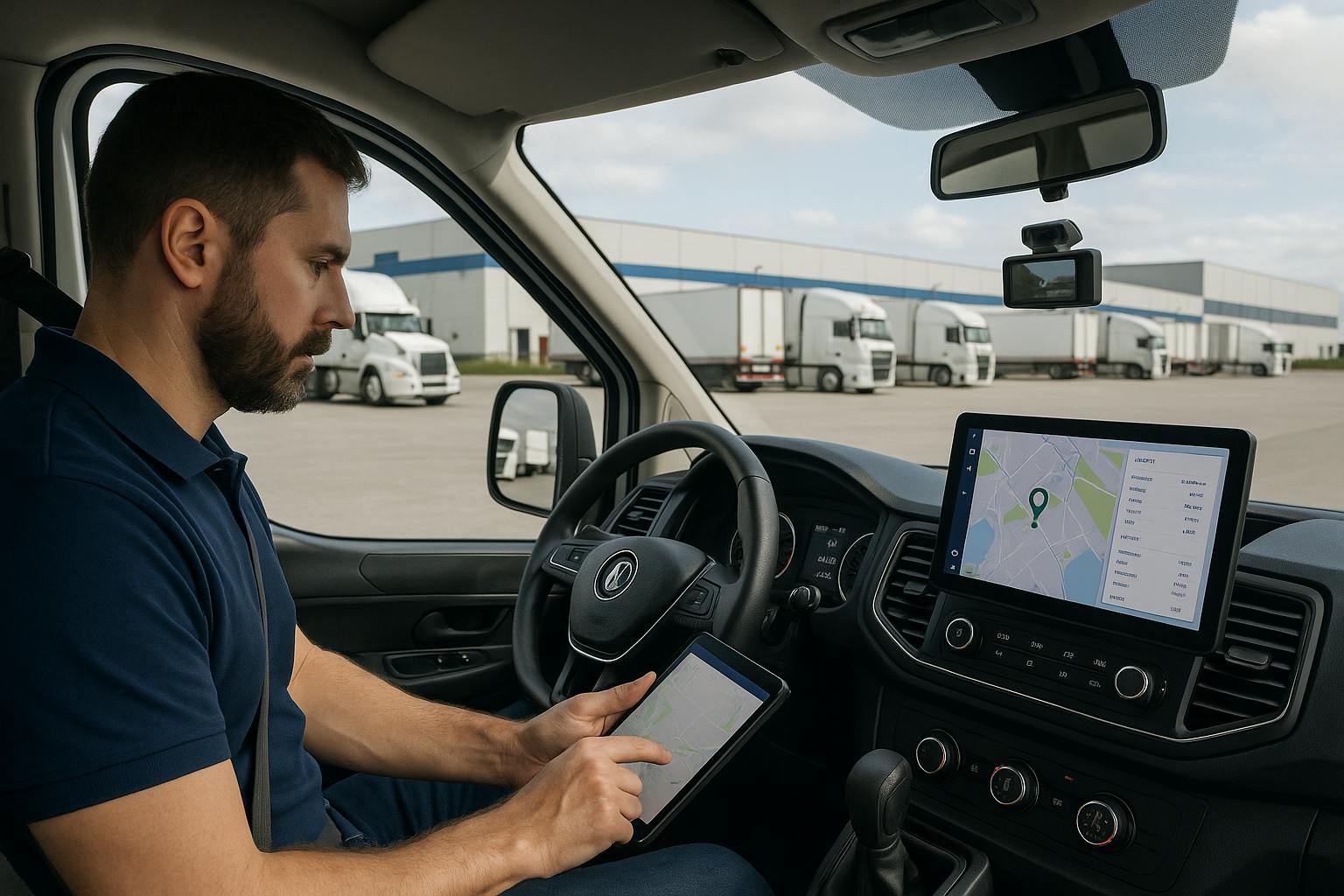
Last Mile Innovation
Oct 6, 2025 - 5min read
ARTICLE
Connected Fleets: How Telematics and Data Are Powering the Next Generation of Logistics
The delivery vehicle is no longer just a truck—it's a data source on wheels. Every commercial vehicle now generates over 8,000 data points per day, capturing everything from GPS coordinates and engine diagnostics to fuel consumption patterns and driver behavior. As logistics moves toward electrification and automation, fleet visibility and performance analytics are redefining operational excellence. Today, telematics, EV fleet management, and predictive maintenance are converging to make fleets smarter, greener, and more efficient than ever before.
The Evolution of Fleet Intelligence
Fleet management once meant manual logs and reactive repairs—a world of clipboards, paper dispatch sheets, and fixing vehicles only after they broke down. Now, real-time data, IoT sensors, and cloud dashboards offer a live view of performance that transforms operations. The shift has been dramatic: by 2025, over 80% of commercial fleets globally will use telematics for tracking and optimization, according to Berg Insight's market forecasts.
This isn't just technology adoption—it's a fundamental reimagining of how fleets operate. Regulatory requirements like the U.S. Electronic Logging Device mandate created baseline connectivity, while economic pressures around fuel costs and driver shortages forced companies to optimize every asset. The result: telematics has moved from a premium feature for large enterprises to an operational necessity across companies of all sizes seeking competitive advantage in an increasingly demanding logistics landscape.
Telematics: The Brain of Modern Fleets
Telematics combines GPS tracking, vehicle diagnostics, and driver behavior monitoring into a unified intelligence platform. The definition is straightforward: telematics = GPS tracking + vehicle diagnostics + driver behavior monitoring. But what it delivers transforms operations:
- Real-time route optimization that adapts to traffic, weather, and delivery windows
- Idle time reduction that cuts fuel waste and emissions
- Driver safety insights that reduce accidents and insurance costs
- Fuel efficiency monitoring that identifies savings opportunities mile by mile
The impact is measurable and significant. Companies like DHL and UPS use telematics to reduce idle time and CO₂ output by 15-20%, while achieving substantial fuel savings across their global operations. DHL's implementation of telematics through what they call a "big bang" deployment—applying the system fleet-wide simultaneously—delivered 10-15% fuel economy gains through vehicle reassignment and route optimization alone. UPS took this even further with ORION, their proprietary system that analyzes over 200,000 routing options per route across 55,000 routes, generating $300-400 million in annual savings while cutting travel by 100 million miles and saving 10 million gallons of fuel yearly.
The Rise of EV Fleet Management
Electrification is accelerating across delivery companies as they adopt EVs to meet sustainability goals and regulatory requirements. 64% of fleet professionals currently operate electric vehicles, with 87% planning electrification within five years according to Qmerit's 2025 survey. The global EV fleet reached 58 million vehicles by the end of 2024, with particularly rapid adoption in last-mile delivery where predictable routes and return-to-base operations simplify charging logistics.
Yet challenges remain substantial. Charging logistics require coordination with utility providers and infrastructure installation. Range management demands careful route planning to avoid stranding vehicles. Battery health monitoring is critical, with batteries typically degrading 1-2% annually—performance that directly impacts operational economics. And TCO visibility reveals a complex picture: heavy-duty trucks face a 30-50% total cost of ownership premium for zero-emission options, while light commercial vehicles have already achieved parity, with EVs costing 15% more upfront but 30-40% less to operate.
The solution lies in EV fleet management platforms that use telematics data to optimize every aspect of electric operations. These systems schedule charging during off-peak utility rates, predict battery health degradation before it impacts operations, optimize routes to stay within optimal charge ranges, and provide real-time TCO visibility that informs fleet transition decisions. The result: lower emissions, lower costs per mile, and better alignment with ESG targets that increasingly drive corporate decision-making. Amazon's deployment of over 25,000 Rivian electric delivery vans demonstrates this at scale—having delivered more than 1 billion packages via these EVs in 2024 alone, supported by 24,000+ chargers at 150+ delivery stations, all managed through sophisticated telematics platforms.
Predictive Maintenance: From Breakdowns to Prevention
The traditional maintenance model is simple but expensive: fix it when it breaks. This reactive approach costs 3-9 times more than scheduled maintenance, creates unpredictable downtime that disrupts customer commitments, and introduces safety risks that endanger drivers and cargo. The new model flips this equation entirely: predict failure before it happens.
Here's how it works. IoT sensors track temperature, vibration, oil pressure, and fluid levels across dozens of vehicle systems. AI analyzes patterns across thousands of vehicles to predict component failure with 94%+ accuracy, often providing 9 days advance notice before breakdown. The impact is transformative: leading implementations achieve up to 30% reduction in unplanned downtime, translating to major cost savings for large fleets.
The business case is compelling. With unplanned downtime costing $500+ per day per vehicle and emergency repairs carrying rush delivery fees plus after-hours labor premiums, predictive maintenance programs typically achieve payback within 6-12 months while generating $15,000-$25,000 in annual savings per truck. Real-world results validate the potential: Coca-Cola Consolidated achieved a 33% increase in uptime after implementation, while Ford Commercial Vehicles saved 122,000 hours of downtime and $7 million on a single component type by predicting 22% of failures 10 days in advance. McKinsey research documents that leading fleets achieve 45% increases in vehicle uptime and 30% reductions in maintenance costs through AI-driven predictive systems.
Integrated Data Systems: The Missing Link
The challenge facing modern fleets isn't lack of data—it's data fragmentation. Fleet data often lives in silos: telematics platforms track vehicle location and performance, maintenance systems log repairs and service intervals, and route planning tools optimize delivery sequences. Each system generates valuable insights, but those insights remain trapped when systems can't communicate.
The integration advantage transforms these isolated data streams into unified intelligence. API-driven platforms now pull vehicle telemetry, historical maintenance records, and real-time traffic data into unified dashboards that connect vehicle, driver, and delivery data. This creates end-to-end visibility across dispatch, carrier operations, and customer touchpoints that was impossible when systems operated independently. When telematics alerts flag a potential engine issue, integrated systems automatically generate maintenance work orders, check parts inventory, and adjust route assignments—all without manual intervention.
This standardization mirrors what's happening across the broader logistics ecosystem. Just as Carriyo standardizes shipment data across multiple carriers to provide unified visibility for the last mile, fleet integration platforms are bringing the same clarity to internal operations. The result: faster decisions, fewer errors, and operational efficiency that compounds as data quality improves.
How Smart Fleets Transform Last-Mile Delivery
Fleet intelligence capabilities become especially powerful in last-mile delivery, where customer expectations for precision and visibility have never been higher. Smart fleets deliver four critical advantages:
Better ETAs: Real-time vehicle data dramatically improves delivery predictability by incorporating actual location, traffic conditions, and historical performance patterns rather than static estimates. Customers receive accurate time windows that reflect reality, reducing missed deliveries and frustration.
Proactive rerouting: Combining telematics with traffic and weather data enables dynamic optimization when conditions change. When accidents block routes or weather slows progress, intelligent systems instantly recalculate paths and adjust schedules before delays cascade through the delivery schedule.
Customer communication: Integrating fleet visibility with branded notifications keeps customers informed throughout the journey. Automated updates trigger when vehicles approach delivery locations, when delays occur, or when delivery preferences need confirmation—all maintaining brand consistency regardless of operational complexity.
Operational synergy: This is where fleet intelligence meets delivery orchestration. Fleet intelligence + Carriyo's multi-carrier orchestration = ultimate delivery precision. While fleet management systems optimize internal operations, Carriyo extends that intelligence across 100+ external carriers, creating unified visibility whether goods move via internal fleet or third-party logistics. The result transforms fleet data into superior customer experiences through branded tracking, proactive communications, and seamless returns management.
Sustainability & Future Outlook
EV + data = greener logistics. The environmental imperative cannot be overstated: transportation contributes 24% of global CO2 emissions, with freight alone responsible for over 30% of transport emissions. The combination of electrification and telematics-driven optimization offers a powerful response. Route optimization delivers 10-15% fuel consumption reduction, while electrifying 30-40% of light vehicle fleets achieves 25-30% carbon footprint reduction within just two years. Optimized routing and predictive maintenance reduce energy waste whether fleets run on diesel or electrons.
Next frontier: The technology roadmap points toward even greater intelligence. AI copilots for dispatchers are emerging, providing natural language interfaces to complex fleet data—managers can now ask conversational questions and receive instant answers from millions of data points. Autonomous delivery integration is accelerating, with the market projected to grow from $18.7 billion in 2023 to $144.2 billion by 2033, and China deploying over 200,000 autonomous delivery units by 2025. Fleet-to-carrier communication through APIs continues standardizing data exchange across previously incompatible systems, enabling seamless coordination across internal and external logistics resources.
Vision: A connected ecosystem where every shipment, driver, and vehicle speaks the same digital language. Where data flows seamlessly from warehouse to vehicle to carrier to customer, creating experiences that are not just efficient but genuinely intelligent—systems that learn, adapt, and continuously improve with every delivery completed.
Conclusion
The future of logistics belongs to connected fleets that combine telematics, EV management, and predictive analytics into intelligent operations. Every vehicle becomes a data source, every route an optimization opportunity, every maintenance event a learning experience. The companies winning in this environment aren't just adopting technology—they're reimagining operations around the intelligence that connected systems provide.
Yet operational excellence means little if customers remain disconnected. The most successful logistics operations extend fleet intelligence beyond internal optimization into customer-facing delivery experiences. This is where platforms like Carriyo create decisive advantage.
Carriyo helps logistics providers extend fleet intelligence to the customer experience—from vehicle data to delivery tracking, every mile is connected. By unifying data from internal fleets and 100+ external carriers across 27+ countries, Carriyo ensures that the intelligence built into fleet operations translates into experiences that drive customer retention and reduce service costs. Branded tracking pages, proactive communications, and seamless returns management maintain consistency whether deliveries move via internal fleet or third-party carriers.
If you're ready to transform your fleet intelligence into exceptional customer experiences, contact our sales team or book a demo today to discover how delivery orchestration can extend your operational excellence into the last mile, creating seamless experiences that customers remember and return for.
01

Joao Vieira
CRO at CARRIYO
Inside the City: How Urban Freight and Micro-Distribution Are Redefining the Last Mile
Oct 7, 2025 - 4min read
02

Faisel Azeez
Co-Founder & CTO
Connected Fleets: How Telematics and Data Are Powering the Next Generation of Logistics
Oct 6, 2025 - 5min read
03

Joao Vieira
CRO at CARRIYO
Last Mile, First Priority: Why Experience Matters More Than Speed
Oct 2, 2025 - 5min read
Automate shipping operations and elevate post-purchase customer experience
We're trusted by

